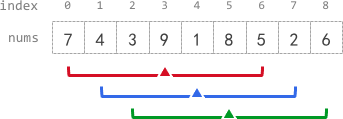- java.lang.Object
-
- g2001_2100.s2090_k_radius_subarray_averages.Solution
-
public class Solution extends Object
2090 - K Radius Subarray Averages.
Medium
You are given a 0-indexed array
numsofnintegers, and an integerk.The k-radius average for a subarray of
numscentered at some indexiwith the radiuskis the average of all elements innumsbetween the indicesi - kandi + k( inclusive ). If there are less thankelements before or after the indexi, then the k-radius average is-1.Build and return an array
avgsof lengthnwhereavgs[i]is the k-radius average for the subarray centered at indexi.The average of
xelements is the sum of thexelements divided byx, using integer division. The integer division truncates toward zero, which means losing its fractional part.- For example, the average of four elements
2,3,1, and5is(2 + 3 + 1 + 5) / 4 = 11 / 4 = 2.75, which truncates to2.
Example 1:

Input: nums = [7,4,3,9,1,8,5,2,6], k = 3
Output: [-1,-1,-1,5,4,4,-1,-1,-1]
Explanation:
-
avg[0], avg[1], and avg[2] are -1 because there are less than k elements before each index.
-
The sum of the subarray centered at index 3 with radius 3 is: 7 + 4 + 3 + 9 + 1 + 8 + 5 = 37.
Using integer division , avg[3] = 37 / 7 = 5.
-
For the subarray centered at index 4, avg[4] = (4 + 3 + 9 + 1 + 8 + 5 + 2) / 7 = 4.
-
For the subarray centered at index 5, avg[5] = (3 + 9 + 1 + 8 + 5 + 2 + 6) / 7 = 4.
-
avg[6], avg[7], and avg[8] are -1 because there are less than k elements after each index.
Example 2:
Input: nums = [100000], k = 0
Output: [100000]
Explanation:
- The sum of the subarray centered at index 0 with radius 0 is: 100000.
avg[0] = 100000 / 1 = 100000.
Example 3:
Input: nums = [8], k = 100000
Output: [-1]
Explanation:
- avg[0] is -1 because there are less than k elements before and after index 0.
Constraints:
n == nums.length-
1 <= n <= 105 -
0 <= nums[i], k <= 105
- For example, the average of four elements
-
-
Constructor Summary
Constructors Constructor and Description Solution()
-
Method Summary
All Methods Instance Methods Concrete Methods Modifier and Type Method and Description int[]getAverages(int[] nums, int k)
-